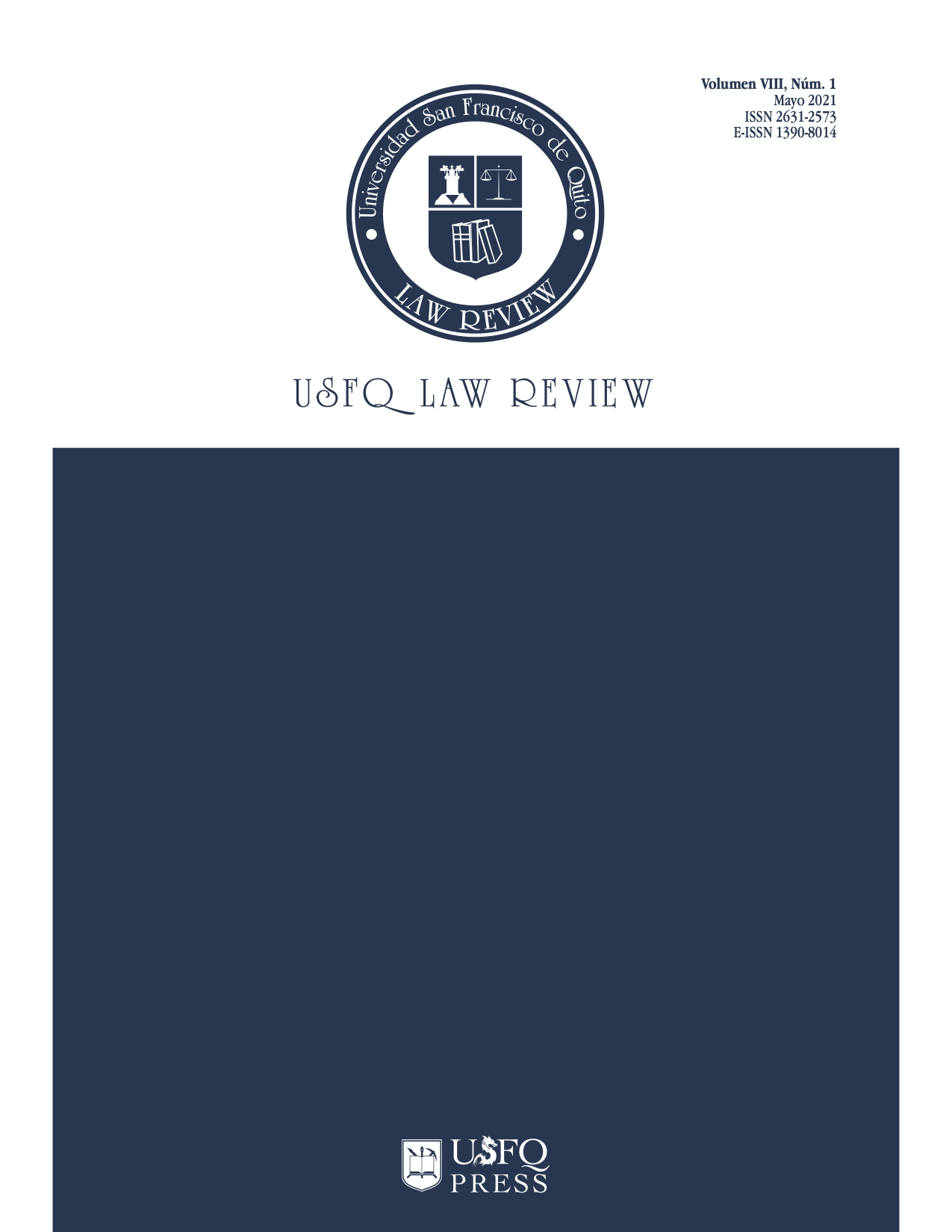Las guerras cibernéticas en el Derecho Internacional Humanitario: aplicación de los principios rectores del DIH
DOI:
https://doi.org/10.18272/ulr.v8i1.2162Keywords:
Cyber warfare, international humanitarian law, distinction principle, precaution principle, proportionality principle.Abstract
Nowadays, one of the most relevant debates in international law, is about the appearence of new technologies employed in directing cyber attacks. This is essential because it could redirection the dynamic in an armed conflict. First hand, it would appear that these attacks could not comply with the traditional principles stated in international humanitarian law (IHL), such as the distinction, proportionality and precaution principles. Therefore, this essay seeks to determine what are the challenges that International Humanitarian law face when dealing with cyber tools.
Downloads
References
Cfr. Traducción libre. Diamond, Eitan. Applying International Humanitarian Law to Cyber Warfare, 2014. https://papers.ssrn.com/sol3/papers.cfm?abstract_id=3093068 (acceso 29/11/2019).
Cfr. Traducción libre. Schaap, Arie. Cyber Warfare Operations: Development and Use under International Law, 2009. https://heinonline.org.ezbiblio.usfq.edu.ec/HOL/Page?collection=journals&handle=hein.journals/airfor64&id=123&men_tab=srchresults (acceso 8/12/2019).
Convenio sobre la Ciberdelincuencia (2001). Artículo 2-11.
Cfr. Traducción libre. Duggan, David & Parks, Raymond. Principles of Cyber warfare, 2011. https://ieeexplore.ieee.org/abstract/document/6029360/references#references (acceso 29/11/2019).
Artículo 49 - Definición de ataques y ámbito de aplicación
1. Se entiende por ataques los actos de violencia contra el adversario, sean ofensivos o defensivos.
Cfr. Traducción libre. ICRC. International Humanitarian Law and Cyber Operations during Armed Conflicts, 2019. https://www.icrc.org/en/document/international-humanitarian-law-and-cyber-operations-during-armed-conflicts acceso (29/11/2019).
Diamond, Eitan. Applying International Humanitarian Law to Cyber Warfare, 2014. https://papers.ssrn.com/sol3/papers.cfm?abstract_id=3093068 (acceso 29/11/2019)
Ibíd.
Protocolo Adicional I a los Convenios de Ginebra para la proteccion de las victimas durante conflicto armado (1977). Artículo 51 numeral 2
Los siguientes casos son todos una traducción libre de inglés a español.
Cfr. Schreier, Fred. On Cyberwarfare, 2015. https://www.dcaf.ch/sites/default/files/publications/documents/OnCyberwarfare-Schreier.pdf (acceso 29/11/2019).
NATO (1999). Nato"™s Role in Kosovo
Cfr. Schreier, Fred. On Cyberwarfare, 2015. https://www.dcaf.ch/sites/default/files/publications/documents/OnCyberwarfare-Schreier.pdf (acceso 29/11/2019)
Cfr. White, Sarah. Understading Cyberwarfare, Lessons from the Russia-Georgia War, 2018. https://mwi.usma.edu/wp-content/uploads/2018/03/Understanding-Cyberwarfare.pdf (acceso 29/11/2019).
Cfr. Schreier, Fred. On Cyberwarfare, 2015. https://www.dcaf.ch/sites/default/files/publications/documents/OnCyberwarfare-Schreier.pdf (acceso 29/11/2019).
Cfr. D"™Ascanio, Margherita. Iran victim of Cyberwarfare, ICRC Casebook, 2015. https://casebook.icrc.org/case-study/iran-victim-cyber-warfare (acceso 29/11/2019).
Cfr. Traducción libre. Lipovsky, Robert. Seven years after Stuxnet: Industrial systems security once again in the spotlight, 2017. https://www.welivesecurity.com/2017/06/16/seven-years-stuxnet-industrial-systems-security-spotlight/
(acceso 08/12/2019).
Cruz Roja Española. (s.n.), Fines y ámbito de aplicación del Derecho Internacional Humanitario. http://www.cruzroja.es/portal/page?_pageid=878,12647065&_dad=portal30&_schema=PORTAL30 (acceso 29/11/2019).
Cfr. Diamond, Eitan. Applying International Humanitarian Law to Cyber Warfare, 2014. https://papers.ssrn.com/sol3/papers.cfm?abstract_id=3093068 (acceso 29/11/2019)
Protocolo I adicional a los Convenios de Ginebra de 1949 relativos a la protección de las víctimas de los conflictos armados internacionales. (1977). Artículo 49.
Cfr. Diamond, Eitan. Applying International Humanitarian Law to Cyber Warfare, 2014. https://papers.ssrn.com/sol3/papers.cfm?abstract_id=3093068 (acceso 29/11/2019)
Ibíd
Cfr. Traducción libre. Ticehurst, Rupert. "La cláusula de Martens y el derecho de los conflictos armados". Revista Internacional de la Cruz Roja (1997) p.1.
Convenio sobre la ciberdelincuencia (2001). Artículo 39.
Convenio sobre la ciberdelincuencia (2001). Artículo 39.
Cfr. Traducción libre. International Groups of Experts at the Invitation of the NATO Cooperative Cyber Defence Centre of Excellence. Tallin Manual on the International Law applicable to Cyber Warfare, 2009, http://csef.ru/media/articles/3990/3990.pdf (acceso 09/12/2019)
Cfr. Íbid., Artículo 30
Protocolo Adicional I a los Convenios de Ginebra de 1949 relativos a la protección de las víctimas de los conflictos armados internacionales. (1977). Artículo 48.
Ibídem.
Protocolo I adicional a los Convenios de Ginebra de 1949 relativos a la protección de las víctimas de los conflictos armados internacionales. (1977). Artículo 51.
Cfr. Traducción libre. Schreier, Fred. On Cyberwarfare, 2015. https://www.dcaf.ch/sites/default/files/publications/documents/OnCyberwarfare-Schreier.pdf (acceso 29/11/2019).
Cfr. Traducción libre. Pascucci, Peter. Distinction and Proportionality in Cyber War: Virtual Problems with a Real Solution, 2017. https://scholarship.law.umn.edu/cgi/viewcontent.cgi?article=1256&context=mjil (acceso: 29/11/2019).
Comité Internacional de la Cruz Roja. ¿Qué limites impone el derecho de la guerra a los ataques cibernéticos? https://www.icrc.org/es/doc/resources/documents/faq/130628-cyber-warfare-q-and-a-eng.htm
(acceso 15/01/2021)
Cfr. Traducción libre. Dinstein, Yoram. The Principle of Distinction and Cyber War in International Armed Conflicts, 2012. https://academic.oup.com/jcsl/article/17/2/261/852776 (acceso: 30/11/2019).
Cfr. Traducción libre. Dinstein, Yoram. The Principle of Distinction and Cyber War in International Armed Conflicts, 2012. https://academic.oup.com/jcsl/article/17/2/261/852776 (acceso: 30/11/2019).
Cfr.Traducción libre. Pascucci, Peter. Distinction and Proportionality in Cyber War: Virtual Problems with a Real Solution, 2017. https://scholarship.law.umn.edu/cgi/viewcontent.cgi?article=1256&context=mjil
(acceso: 29/11/2019).
Protocolo I adicional a los Convenios de Ginebra de 1949 relativos a la protección de las víctimas de los conflictos armados internacionales. (1977). Artículo 51 numeral 3.
Cfr. Melzer, Nils. Guía para Interpretar la Noción de Participación Directa en las Hostilidades según el Derecho Internacional Humanitario, 2010. https://www.icrc.org/es/publication/guia-participacion-directa-hostilidades-derecho-internacional-humanitario-dih (acceso: 10/12/2019).
Reguera, Jesús. Aspectos legales en el ciberespacio. La ciberguerra y el derecho internacional humanitario, 2015. http://www.seguridadinternacional.es/?q=es/content/aspectos-legales-en-el-ciberespacio-la-ciberguerra-y-el-derecho-internacional-humanitario
(acceso: 29/11/2019).
Cfr.Traducción libre. International Groups of Experts at the Invitation of the NATO Cooperative Cyber Defence Centre of Excellence. Tallin Manual on the International Law applicable to Cyber Warfare, 2009, http://csef.ru/media/articles/3990/3990.pdf (acceso 09/12/2019)
Cfr. Reguera, Jesús. Aspectos legales en el ciberespacio. La ciberguerra y el derecho internacional humanitario, 2015. http://www.seguridadinternacional.es/?q=es/content/aspectos-legales-en-el-ciberespacio-la-ciberguerra-y-el-derecho-internacional-humanitario
(acceso: 29/11/2019).
Published
How to Cite
Issue
Section
License
Copyright (c) 2021 Camila Manotas, Irina Burgaentzle

This work is licensed under a Creative Commons Attribution-NonCommercial-ShareAlike 4.0 International License.
In relation to copy rights, authors publishing with USFQ Law Review know and accept its internal policies, including but not limited to:
1. Open Access Policy.
2. Authorship Policy.
3. Copyright Policy.
4. Pre-Publication Policy.
5. Post-Publication Policy.
6. Intellectual Property Protection Policy.
7. Digital Preservation Policy.


